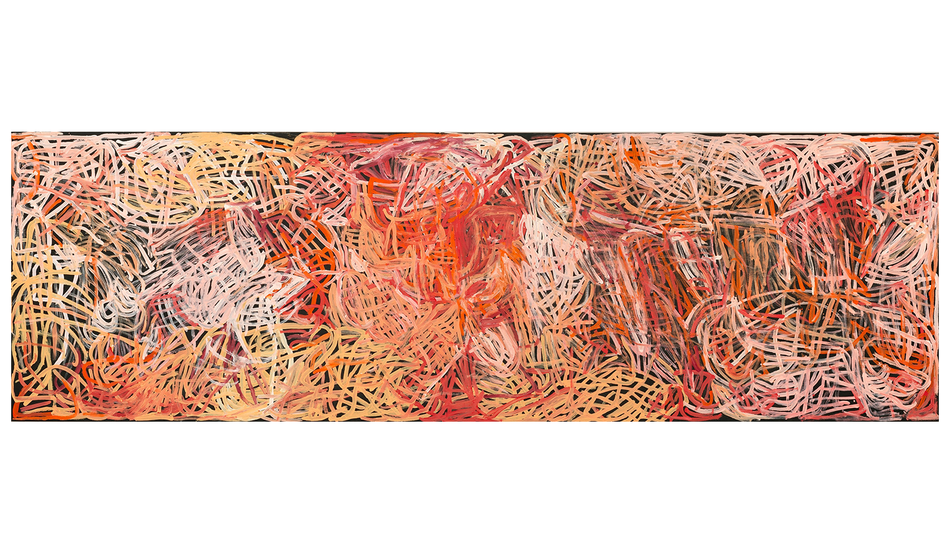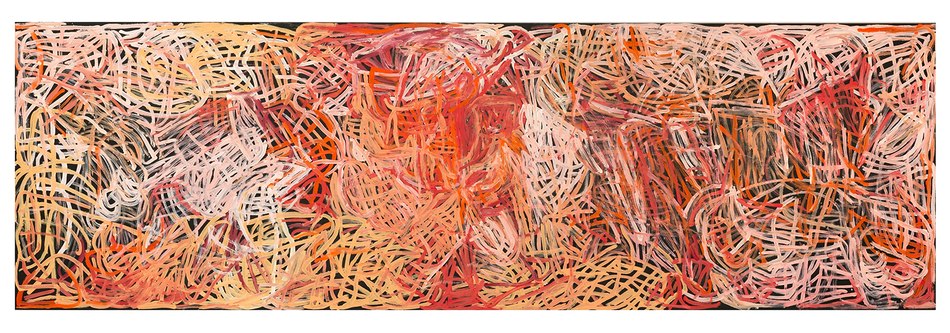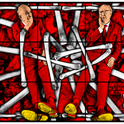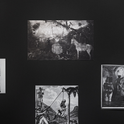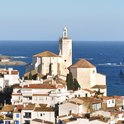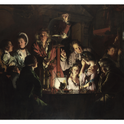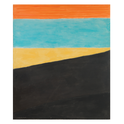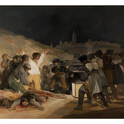Aboriginal and Torres Strait Islander people should be aware that this story contains the names of deceased persons
Staring at the spaghetti tree of colourful lines that is Yam awely, a painting by renowned Australian artist and Anmatyerr woman Emily Kam Kngwarray, currently hung in the final room of the Tate Modern’s new retrospective of her work, my mind was cast back 10 years.
A skint undergraduate student in Melbourne sick of being underpaid at a suburban pizza shop, I had just attained a casual customer service role at the National Gallery of Victoria. My job was to rip people’s tickets on entry, tell them where the bathrooms were and suchlike. On my application, I had slightly overegged my visual art knowledge. I could just about tell an impressionist from an expressionist, but the curly questions from the more sophisticated art lovers induced, somewhat appropriately, a sense of imposter syndrome.
Another thing I often had to do was direct people to specific works, and there was one in particular I quickly memorised. I can still remember the directions to it now, as it was perhaps one of the most sought-after in the gallery’s Australian collection after John Brack’s iconic Collins Street 5pm (1955). It’s moved around since but, back then, you’d go up the escalator to level two, take a right and there you’d find Kngwarray’s Anwerlarr anganenty (Big yam Dreaming) from 1995.
Painted in the same year as Yam awely, Anwerlarr anganenty is strikingly similar—indeed, the latter is essentially a monochromatic cousin of the former. Given its popularity and the mesmerising nature of Kngwarray’s snaking lines, I found myself spending time with Anwerlarr anganenty on my lunch breaks, feeling my breathing slow and my curiosity heighten. It is a remarkable piece.
In a way, my artistic naivety helped me appreciate Kngwarray’s work—or, rather, it prevented me from misinterpreting it, as so many art critics once had. Seeing her use of vibrant colours, dots and lines, often non-figurative in the western sense—with some works looking superficially like Jackson Pollock—many miscast Kngwarray as an abstract expressionist. In a 1989 issue of Time Out, on the wave of global interest in Aboriginal art that turned Kngwarray and her peers into stars of the late 1980s and 1990s art scene, the New Yorker’s infamously dismissive art critic Peter Schjeldahl described their paintings as “turgid and nerveless... they look like a type of abstraction briefly fashionable in the early 1970s, when this project was born”.
But Kngwarray was not painting in the tradition of modernist abstraction. Rather, she was adding flourishes and innovations to the centuries-old traditions of Aboriginal art. In particular, she was painting her Country—Alhalker, part of Utopia in the Sandover region where Kngwarray lived.
“Kngwarray’s work isn’t just about what’s visually appealing; it’s deeply rooted in her Anmatyerr heritage, her spiritual connection to Alhalker—which is her Country—and the intricate knowledge of her homeland,” says Kelli Cole, one of the curators of the Tate exhibition. “By presenting her art through the lens of her own world, as we aimed to do, we can challenge preconceived notions and offer a more nuanced, respectful and authentic engagement with indigenous art and worldviews.”
Cole, a Warumungu and Luritja woman, is from Mparntwe/Alice Springs in Australia’s Northern Territory, a few hours’ drive from where Kngwarray lived. The life partner of her uncle Robert Ambrose Cole—himself a renowned First Nations artist—was Rodney Gooch, an art adviser for the Central Australian Aboriginal Media Association in the Sandover region. “Whenever Emily and the other Utopia artists were in Alice Springs, they often painted at Rodney’s house, finding both shade and inspiration under his veranda,” she recalls.
Standing in front of Anwerlarr anganenty at age 19, I had what I worried was an embarrassingly rudimentary initial interpretation: “It looks like the roots of a plant or a tree.” I was, it turns out, far closer to the mark than Schjeldahl and many other professional critics. Kngwarray’s line-heavy phase in the mid-1990s, just prior to her death in 1996, centred on the representation of a particular motif: the anwerlarr (pencil yam), a long trailing vine commonly found across eastern and northern Australia. Their seedpods and encased seeds are called kam—Emily Kam Kngwarray’s namesake. The colours in Yam awely represent the changing colours of kam throughout the plant’s life cycle, which Anmatyerr people link to the human life cycle—the white ones are ampa akely (children), the yellow ones awenk (teenage girls) and the reddish-brown ones arelh ampwa (old women). For Kngwarray and her people, the anwerlarr is an important Dreaming—a term which refers to the time when ancestral beings travelled across and shaped the landscape, but also to the ancestral beings themselves and their ongoing presence on Country. “The pencil yam grows in our Country—it belongs to us—the anwelarr yam,” Kngwarray said in 1992. “That’s what I painted.”
In 1995 Kngwarray was herself an arelh ampwa, at 85 years old. She had seen a lot, and still had a lot to say about it. Born in 1910, she did not see a white person until she was nine years old. Her land was then parcelled out by the federal government to white settlers for agricultural development, and Kngwarray worked on their cattle stations. The land was eventually returned to traditional ownership in the latter half of the 20th century. Unbelievably for an artist of such renown, she only began painting on canvas in 1988, at the age of 78—though she had begun using batik (a fabric dying technique using wax, originally from Indonesia) in 1977 and had long used ceremonial body paint. After a rapid rise to prominence, she represented Australia alongside fellow indigenous artists Yvonne Koolmatrie and Judy Watson at the Venice Biennale in 1993.
Tate Modern’s current show, however, is the first major solo exhibition of her work in Europe. It is a fitting change of heart for a gallery that once, as recently revealed by Melbourne newspaper the Age, declined when London gallery owner Rebecca Hossack asked them to consider adding indigenous works to its collection in August 1996.
“Tate hosting this significant First Nations exhibition is in itself a powerful statement,” says Cole. “It’s a real chance to move beyond older Eurocentric views, and open up a global conversation about diverse art histories.”
Emily Kam Kngwarray is on display at Tate Modern until 11th January 2026
